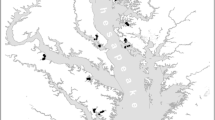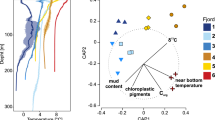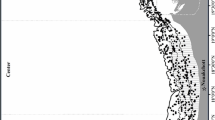Abstract
Body size is related to an extensive number of species traits and ecological processes and has therefore been suggested as an effective metric to assess community changes and ecosystem’s state. However, the applicability of body size as an ecological indicator in benthic environments has been hindered by the poor knowledge of the factors influencing the size spectra of organisms. By applying biological trait analysis (BTA) and generalized linear models to a species dataset collected in the German Wadden Sea (53°41′14′′ N, 7°14′19′′ E) between 1999 and 2012, we show that the size structure of the macrobenthic community changes predictably along environmental gradients. Specifically, body size increases with increasing current-induced shear stress and sediment organic matter content. In addition, the presence of oyster–mussel reefs in one of the sampling stations enhanced the survival of species belonging to the smallest size categories in habitats with high hydrodynamic energy. This was probably due to the local sheltering effects, which together with biodeposition also increased organic matter in the sediment, likely favoring large deposit feeders as well. Our results suggest that body size can be a useful trait for estimating effects of anthropogenic stressors, such as organic enrichment or alteration of hydrodynamic regime and could therefore be effectively included in current monitoring programs of intertidal macrobenthic communities.




Similar content being viewed by others
References
Abelson A, Denny M (1997) Settlement of marine organisms in flow. Annu Rev Ecol Syst 28:317–339
Airoldi L, Beck MW (2007) Loss, status and trends for coastal marine habitats of Europe. In: Gibson RN, Atkinson RJA, Gordon JDM (eds) Oceanography and Marine biology: an annual review, vol 45. CRC Press, Boca Raton, pp 345–405
Allen C, Garmestani A, Havlicek T, Marquet P, Peterson G, Restrepo C, Stow C, Weeks B (2006) Patterns in body mass distributions: sifting among alternative hypotheses. Ecol Lett 9:630–643. doi:10.1111/j.1461-0248.2006.00902.x
Armonies W, Hellwig-Armonies M (1992) Passive settlement of Macoma balthica spat on tidal flats of the Wadden Sea and subsequent migration of juveniles. Neth J Sea Res 29:371–378
Basset A, Barbone E, Borja A et al (2012) A benthic macroinvertebrate size spectra index for implementing the water framework directive in coastal lagoons in Mediterranean and Black Sea ecoregions. Ecol Indic 12:72–83. doi:10.1016/j.ecolind.2011.06.012
Beck M (1995) Size-specific shelter limitation in stone crabs: a test of the demographic bottleneck hypothesis. Ecology 76:968–980
Becker G, Dick S, Dippner J (1992) Hydrography of the German bight. Mar Ecol Prog Ser 91:9–18
Borgmann U (1987) Models on the slope of, and biomass flow up, the biomass size spectrum. Can J Fish Aquat Sci 44:136–140
Borja A, Barbone E, Basset A, Basset A, Borgersen G, Brkljacic M, Elliott M, Garmendia JM, Marques JC, Mazik K, Muxika I, Magalhães Neto J, Norling K, Rodríguez JG, Rosati I, Rygg B, Teixeira H, Trayanova A (2011) Response of single benthic metrics and multi-metric methods to anthropogenic pressure gradients, in five distinct European coastal and transitional ecosystems. Mar Pollut Bull 62:499–513. doi:10.1016/j.marpolbul.2010.12.009
Bouma H, Duiker JMC, de Vries PP, Herman PMJ, Wolff WJ (2001) Spatial pattern of early recruitment of Macoma balthica (L.) and Cerastoderma edule (L.) in relation to sediment dynamics on a highly dynamic intertidal sandflat. J Sea Res 45:79–93
Bourassa N, Morin A (1995) Relationships between size structure of invertebrate assemblages and trophy and substrate composition in streams. J North Am Benthol Soc 14:393–403. doi:10.2307/1467205
Bremner J, Rogers S, Frid C (2006) Methods for describing ecological functioning of marine benthic assemblages using biological traits analysis (BTA). Ecol Indic 6:609–622. doi:10.1016/j.ecolind.2005.08.026
Bromley R (1990) Trace fossils: Biology and Taphonomy. Unwin Hyman, London
Brooks J, Dodson S (1965) Predation, body size, and composition of plankton. Science 150:28–35
Brown J, Marquet P, Taper M (1993) Evolution of body size: consequences of an energetic definition of fitness. Am Nat 142:573–584
Brown J, Gillooly J, Allen A, Savage VM, West GB (2004) Toward a metabolic theory of ecology. Ecology 85:1771–1789
Calder W A III (1984) Size, function and life history. Harvard University Press, Cambridge
Charvet S, Kosmala A, Statzner B (1998) Biomonitoring through biological traits of benthic macroinvertebrates: perspectives for a general tool in stream management. Arch Fur Hydrobiol 142:415–432
Chen C, Liu H, Beardsley R (2003) An unstructured grid, finite-volume, three-dimensional, primitive equations ocean model: application to coastal ocean and estuaries. J At Ocean Technol 20:159–186
Chevenet F, Dolédec S, Chessel D (1994) A fuzzy coding approach for the analysis of long-term ecological data. Freshw Biol 31:295–309
Cochran WG (1977) Sampling techniques, 3rd edn. Wiley, New York
Commito JA, Celano EA, Celico HJ, Como S, Johnson CP (2005) Mussels matter: postlarval dispersal dynamics altered by a spatially complex ecosystem engineer. J Exp Mar Biol Ecol 316:133–147. doi:10.1016/j.jembe.2004.10.010
Damuth JD (1992) Taxon-free characterization of animal communities. In: Behrensmeyer AK, Damuth JD, DiMichele WA, Potts R, Sues H, Wing SL (eds) Terrestrial ecosystems through time: evolutionary paleoecology of terrestrial plants and animals. University of Chicago Press, Chicago, pp 183–203
De Roos AM, Persson L, McCauley E (2003) The influence of size-dependent life-history traits on the structure and dynamics of populations and communities. Ecol Lett 6:473–487. doi:10.1046/j.1461-0248.2003.00458.x
Defeo O, McLachlan A (2011) Coupling between macrofauna community structure and beach type: a deconstructive meta-analysis. Mar Ecol Prog Ser 433:29–41. doi:10.3354/meps09206
Defeo O, McLachlan A (2013) Global patterns in sandy beach macrofauna: species richness, abundance, biomass and body size. Geomorphology 199:106–114. doi:10.1016/j.geomorph.2013.04.013
Denny M, Wethey D (2001) Physical processes that generate patterns in marine communities. In: Bertness MD, Gaines SD, Hay ME (eds) Marine community ecology. Sinauer Associates, Sunderland, pp 3–37
Dolbeth M, Raffaelli D, Pardal MÂ (2014) Patterns in estuarine macrofauna body size distributions: the role of habitat and disturbance impact. J Sea Res 85:404–412. doi:10.1016/j.seares.2013.07.012
Donadi S, van der Heide T, van der Zee EM, Eklöf JS, van de Koppel J, Weerman EJ, Piersma T, Olff H, Eriksson BK (2013) Cross-habitat interactions among bivalve species control community structure on intertidal flats. Ecology 94:489–498
Donadi S, van der Zee EM, van der Heide T, Weerman EJ, Piersma T, van de Koppel J, Olff H, Bartelds M, van Gerwen I, Eriksson BK (2014) The bivalve loop: intra-specific facilitation in burrowing cockles through habitat modification. J Exp Mar Biol Ecol 461:44–52. doi:10.1016/j.jembe.2014.07.019
Eckman JE (1983) Hydrodynamic processes affecting benthic recruitment. Limnol Oceanogr 28:241–257
Edgar GJ, Shaw C, Watson GF, Hammond LS (1994) Comparisons of species richness, size-structure and production of benthos in vegetated and unvegetated habitats in Western Port, Victoria. J Exp Mar Biol Ecol 176(2):201–226
Emmerson MC, Raffaelli D (2004) Predator-prey body size, interaction strength and the stability of a real food web. J Anim Ecol 73:399–409. doi:10.1111/j.0021-8790.2004.00818.x
Eriksson BK, Heide T, van de Koppel J, Piersma T, van der Weer HW, Olff H (2010) Major changes in the ecology of the Wadden Sea: human impacts, ecosystem engineering and sediment dynamics. Ecosystems 13:752–764. doi:10.1007/s10021-010-9352-3
Etienne RS, de Visser SN, Janzen T, Olsen JL, Olff H, Rosindell J (2012) Can clade age alone explain the relationship between body size and diversity? Interface focus 2:170–179
Gatz D, Smith L (1995) The standard error of a weighted mean concentration—1. Bootstrapping vs other methods. Atmos Environ 29:1185–1193
Gee JM, Warwick RM (1994) Metazoan community structure in relation to the fractal dimensions of marine macroalgae. Mar Ecol Prog Ser 103:141–150
Gillooly JF, Brown JH, West GB, Savage VM, Charnov EL (2001) Effects of size and temperature on metabolic rate. Science 293:2248–2251. doi:10.1126/science.1061967
Gould SJ (1966) Allometry and size in ontogeny and phylogeny. Biol Rev Camb Philos Soc 41:587–640
Graf G, Rosenberg R (1997) Bioresuspension and biodeposition: a review. J Mar Syst 11:269–278
Hacker S, Steneck R (1990) Habitat architecture and the abundance and body-size-dependent habitat selection of a phytal amphipod. Ecology 71:2269–2285
Holling C (1992) Cross-scale morphology, geometry, and dynamics of ecosystems. Ecosyst Manag 62:447–502
Hrbacek J, Dvorakova M, Korinek V, Prochazkova L (1961) Demonstration of the effect of the fish stock on the species composition of the zooplankton and the intensity of metabolism of the whole plankton association. Verhandlungen der Int Vereinigung fiir Theore- tische und Angew Limnol 14:192–195
Jones D, Frid CLJ (2009) Altering intertidal sediment topography: effects on biodiversity and ecosystem functioning. Mar Ecol 30:83–96. doi:10.1111/j.1439-0485.2009.00306.x
Jones CG, Lawton JH, Shachak M (1994) Organisms as ecosystem engineers. Oikos 69:373–386
Kleibert M (1932) Body size and metabolism. Hilgardia 6:315–352
Koehl M (1996) When does morphology matter? Annu Rev Ecol Syst 27:501–542
Kösters F, Winter C (2014) Exploring German Bight coastal morphodynamics based on modelled bed shear stress. Geo-Mar Lett 34:21–36. doi:10.1007/s00367-013-0346-y
Kröncke I (1996) Impact of biodeposition on macrofaunal communities in intertidal sandflats. Mar Ecol 17:159–174
Leaper R, Raffaelli D, Emes C, Manly B (2001) Constraints on body-size distributions: an experimental test of the habitat architecture hypothesis. J Anim Ecol 70:248–259
Lettmann KA, Wolff O-J, Badewien TH (2009) Modeling the impact of wind and waves on suspended particulate matter fluxes in the East Frisian Wadden Sea (southern North Sea). Ocean Dyn Spec Issue Biogeochem tidal flats 59:239–262
Litchman E, Klausmeier C (2008) Trait-based community ecology of phytoplankton. Annu Rev Ecol Evol Syst 39:615–639
Losi V, Moreno M, Gaozza L, Vezzulli L, Fabiano M, Albertelli G (2013) Nematode biomass and allometric attributes as indicators of environmental quality in a Mediterranean harbour (Ligurian Sea, Italy). Ecol Indic 30:80–89. doi:10.1016/j.ecolind.2013.01.034
MacDonald TA, Burd BJ, van Roodselaar A (2012) Size structure of marine soft-bottom macrobenthic communities across natural habitat gradients: implications for productivity and ecosystem function. PLoS ONE 7:e40071. doi:10.1371/journal.pone.0040071
Marquet PA, Quiñones RA, Abades S, Labra F, Tognelli M, Arim M, Rivadeneira M (2005) Scaling and power-laws in ecological systems. J Exp Biol 208:1749–1769. doi:10.1242/jeb.01588
McLachlan A, Dorvlo A (2007) Global patterns in sandy beach macrobenthic communities: biological factors. J Coast Res 235:1081–1087. doi:10.2112/04-0408.1
Mills EL, Green DM, Schiavone A (1987) Use of zooplankton size to assess the community structure of fish populations in freshwater lakes. North Am J Fish Manag 7:369–378
Montgomery DC, Peck EA (1992) Introduction to linear regression analysis. Wiley, New York
Mouillot D, Spatharis S, Reizopoulou S, Laugier T, Sabetta L, Basset A, Do Chi T (2006) Alternatives to taxonomic-based approaches to assess changes in transitional water communities. Aquat Conserv Mar Freshw Ecosyst 16:469–482. doi:10.1002/aqc.769
Parry DM, Kendall MA, Rowden AA, Widdicombe S (1999) Species body size distribution patterns of marine benthic macrofauna assemblages from contrasting sediment types. J Mar Biol Assoc UK 79:793–801. doi:10.1017/S0025315499000971
Pennings S (1990) Predator-prey interactions in opisthobranch gastropods: effects of prey body size and habitat complexity. Mar Ecol Prog Ser 62:95–101
Peters R (1983) The ecological implications of body size. Cambridge University Press, Cambridge
Pinna M, Marini G, Rosati I, Neto JM, Patrício J, Marques JC, Basset A (2013) The usefulness of large body-size macroinvertebrates in the rapid ecological assessment of Mediterranean lagoons. Ecol Indic 29:48–61. doi:10.1016/j.ecolind.2012.12.011
Pinna M, Marini G, Mancinelli G, Basset A (2014) Influence of sampling effort on ecological descriptors and indicators in perturbed and unperturbed conditions: a study case using benthic macroinvertebrates in Mediterranean transitional waters. Ecol Indic 37:27–39. doi:10.1016/j.ecolind.2013.09.038
Raffaelli D, Hall S, Emes C, Manly B (2000) Constraints on body size distributions: an experimental approach using a small-scale system. Oecologia 122:389–398
Reizopoulou S, Nicolaidou A (2007) Index of size distribution (ISD): a method of quality assessment for coastal lagoons. Hydrobiologia 577:141–149. doi:10.1007/s10750-006-0423-6
Robson BJ, Barmuta LA, Fairweather PG (2005) Methodological and conceptual issues in the search for a relationship between animal body-size distributions and benthic habitat architecture. Mar Freshw Res 56:1. doi:10.1071/MF04210
Schmid P (2000) Fractal properties of habitat and patch structure in benthic ecosystems. Adv Ecol Res 30:339–401
Schmid P, Tokeshi M, Schmid-Araya J (2002) Scaling in stream communities. Proc R Soc B Biol Sci 269:2587–2594
Schmidt-Nielsen K (1984) Scaling. Why is animal size so important? Cambridge University Press, New York
Schwinghamer P (1981) Characteristic size distributions of integral benthic communities. Can J Fish Aquat Sci 38:1255–1263
Solan M, Cardinale BJ, Downing AL et al (2004) Extinction and ecosystem function in the marine benthos. Science 306:1177–1180. doi:10.1126/science.1103960
Šorf M, Brandl Z, Znachor P, Vašek M (2014) Different effects of planktonic invertebrate predators and fish on the plankton community in experimental mesocosms. Ann Limnol Int J Limnol 50:71–83. doi:10.1051/limn/2014001
Soulsby R (1997) Dynamics of marine sands: a manual for practical applications. Thomas Telford, London
Sprules WG, Munawar M (1986) Plankton size spectra in relation to ecosystem productivity, size and perturbation. Can J Fish Aquat Sci 43:1789–1794
Strayer DL (1991) Perspectives on the size structure of lacustrine zoobenthos, its causes, and its consequences. J North Am Benthol Soc 10:210–221. doi:10.2307/1467579
Ter Braak CJF, Smilauer P (2002) CANOCO Reference manual and CanoDraw for Windows user’s Guide: software for Canonical community ordination (ver. 4.5). Microcomputer Power, New York
Thiel H (1975) The size-structure of the deep-sea benthos. Int Rev Gesamt Hydrobiol 60:575–606
Tokeshi M, Arakaki S (2012) Habitat complexity in aquatic systems: fractals and beyond. Hydrobiologia 685:27–47. doi:10.1007/s10750-011-0832-z
Volkenborn N, Reise K (2007) Effects of Arenicola marina on polychaete functional diversity revealed by large-scale experimental lugworm exclusion. J Sea Res 57:78–88. doi:10.1016/j.seares.2006.08.002
Warner JC, Sherwood CR, Signell RP, Harris CK, Arango HG (2008) Development of a three-dimensional, regional, coupled wave, current, and sediment-transport model. Comput Geosci 34:1284–1306. doi:10.1016/j.cageo.2008.02.012
Warwick RM (1984) Species size distributions in marine benthic communities. Oecologia 61:32–41
West GB, Brown JH, Enquist BJ (1997) A general model for the origin of allometric scaling laws in biology. Science 276:122–126. doi:10.1126/science.276.5309.122
Widdows J, Brinsley M (2002) Impact of biotic and abiotic processes on sediment dynamics and the consequences to the structure and functioning of the intertidal zone. J Sea Res 48:143–156. doi:10.1016/S1385-1101(02)00148-X
Wigley R, McIntyre A (1964) Some quantitative comparisons of offshore meiobenthos and macrobenthos south of Martha’s Vineyard. Limnol Oceanogr 9:485–493
Woodward G, Ebenman B, Emmerson M, Montoya JM, Olesen JM, Valido A, Warren PH (2005) Body size in ecological networks. Trends Ecol Evol 20:402–409. doi:10.1016/j.tree.2005.04.005
Wright J, Jones C, Flecker A (2002) An ecosystem engineer, the beaver, increases species richness at the landscape scale. Oecologia 132:96–101. doi:10.1007/s00442-002-0929-1
Yamanaka T, White PCL, Spencer M, Raffaelli D (2012) Patterns and processes in abundance-body size relationships for marine benthic invertebrates. J Anim Ecol 81:463–471. doi:10.1111/j.1365-2656.2011.01921.x
Zeuthen E (1953) Oxygen uptake as related to body size in organisms. Q Rev Biol 28:1–12
Zuur AF, Ieno EN, Elphick CS (2010) A protocol for data exploration to avoid common statistical problems. Methods Ecol Evol 1:1–12. doi:10.1111/j.2041-210X.2009.00001.x
Acknowledgments
We thank the Lower Saxony Water Management, Coastal Defence and Nature Conservation Agency and the National Park “Niedersächsisches Wattenmeer” for providing the data and Professor Dr Changsheng Chen, Dr Jianhua Qi and the MEDM research group in SMAST-University of Massachusetts Dartmouth for providing the FVCOM source codes and advisory help. We thank two anonymous reviewers for helpful comments on earlier drafts of this manuscript. This study was financed by fellowship to SD from the Hanse-Wissenschaftkolleg—Institute for Advanced Study, to which we are very grateful. HH and DH were financed by the Lower Saxony Ministry for Environment and Climate Protection and the Lower Saxony Ministry for Science and Culture as part of the collaborative research project WiMo (“Wissenschaftliche Monitoringkonzepte für die Deutsche Bucht”). The contribution of Karsten Lettmann was partly supported by the KLIFF research project (“Climate impact and adaptation research in Lower Saxony” funded by the Ministry of Science and Culture of Lower Saxony). The FVCOM model simulations were performed on the massive parallel computer clusters of The North-German Supercomputing Alliance (HLRN, Berlin/Hannover) and the DFG-funded High-Performance-Computing-Cluster (HPC-Cluster) located at the University of Oldenburg.
Conflict of interest
Serena Donadi, Britas Klemens Eriksson, Karsten Alexander Lettmann, Dorothee Hodapp, Jörg-Olaf Wolff and Helmut Hillebrand declare that they have no conflict of interest. All institutional and national guidelines for the care and use of laboratory animals were followed.
Author information
Authors and Affiliations
Corresponding author
Additional information
Communicated by F. Bulleri.
Electronic supplementary material
Below is the link to the electronic supplementary material.
Rights and permissions
About this article
Cite this article
Donadi, S., Eriksson, B.K., Lettmann, K.A. et al. The body-size structure of macrobenthos changes predictably along gradients of hydrodynamic stress and organic enrichment. Mar Biol 162, 675–685 (2015). https://doi.org/10.1007/s00227-015-2614-z
Received:
Accepted:
Published:
Issue Date:
DOI: https://doi.org/10.1007/s00227-015-2614-z




